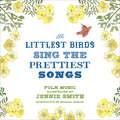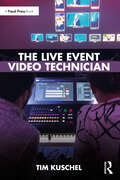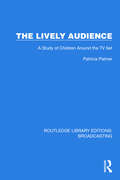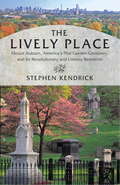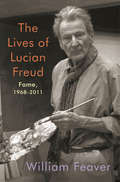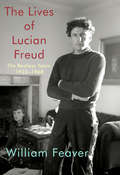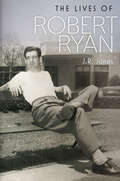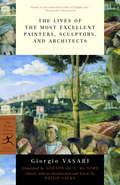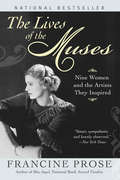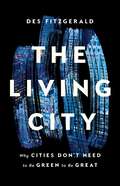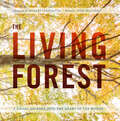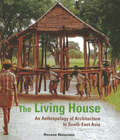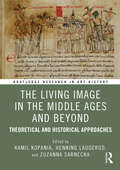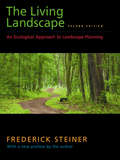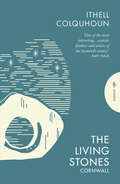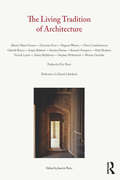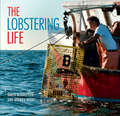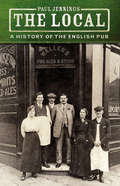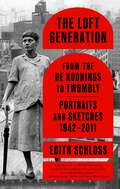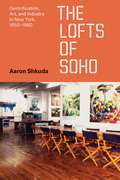- Table View
- List View
The Littlest Birds Sing the Prettiest Songs: Folk Music
by Michael Hurley Jennie SmithOur love affair with folk songs runs as deep as the enduring power of music, nature, creativity, and the longings of the human heart. Artist Jennie Smith celebrates the tradition with her illustrated renderings of thirteen soulful songs, including time-honored Scottish ballads, classics by the likes of the Carter Family, contemporary favorites by Gillian Welch, and more. Smith's art--hopeful, sincere, and delicate--adds an unexpected and charming dimension to a familiar genre. With a foreword from contemporary folk legend Michael Hurley, complete lyrics, and playable tablature or sheet music for each song, this is a keepsake collection for the whole family to treasure.
The Live Event Video Technician
by Tim KuschelThe Live Event Video Technician covers terms, format types, concepts, and technologies used in video production for corporate meetings, concerts, special events, and theatrical productions. The book begins by providing a history of the industry and an overview of important roles and functions therein. It then discusses various display technologies such as LED walls and video projection, as well as video systems for converting and switching of various types of sources. Presenting the cornerstone formats, connectors, and methodologies of visual technology, this book offers a strong foundation to help readers navigate this ever-changing field. Written in an accessible tone, the book clarifies jargon and is an overarching source of knowledge for the role of the video technician, for which there has previously been little formal training. The Live Event Video Technician provides a wealth of practical information for students of media and communications courses, readers with a novice or entry-level understanding of video and AV production, and anyone with an interest in working as technical personnel in live event production.
The Lively Arts of the London Stage, 1675–1725 (Performance in the Long Eighteenth Century: Studies in Theatre, Music, Dance)
by Kathryn LowerreUnlike collections of essays which focus on a single century or whose authors are drawn from a single discipline, this collection reflects the myriad performance options available to London audiences, offering readers a composite portrait of the music, drama, and dance productions that characterized this rich period. Just as the performing arts were deeply interrelated, the essays presented here, by scholars from a range of fields, engage in dialogue with others in the volume. The opening section examines a famous series of 1701 performances based on the competition between composers to set William Congreve's masque The Judgment of Paris to music. The essays in the central section (the 'mainpiece') showcase performers and productions on the London stage from a variety of perspectives, including English 'tastes' in art and music, the use of dance, the depiction of madness and masculinity in both spoken and musical performances, and genres and modes in the context of contemporary criticism and theatrical practice. A brief afterpiece looks at comic pieces in relation to satire, parody and homage. By bringing together work by scholars of music, dance, and drama, this cross-disciplinary collection illuminates the interconnecting strands that shaped a vibrant theatrical world.
The Lively Audience: A Study of Children Around the TV Set (Routledge Library Editions: Broadcasting #25)
by Patricia PalmerThe Lively Audience (1986) studies television from the children’s own point of view. Contrary to most prevailing opinion, it contends that television has much to teach children, and that their relationship with the medium is not one of passive dependency after all. Research shows that what children gain from television depends very much on the child’s age and social experience, and that children ‘see’ television differently from adults. This book examines this issue, and gives us a different understanding of the child audience and the impact of their television viewing.
The Lively Place
by Stephen KendrickThe story of one of the Boston area's most famous attractions, the Mount Auburn Cemetery, and how its founders and "residents" have influenced American culture When the Mount Auburn Cemetery was founded, in 1831, it revolutionized the way Americans mourned the dead by offering a peaceful space for contemplation. This cemetery, located not far from Harvard University, was also a place that reflected and instilled an imperative to preserve and protect nature in a rapidly industrializing culture--lessons that would influence the creation of Central Park, the cemetery at Gettysburg, and the National Parks system. Even today this urban wildlife habitat and nationally recognized hotspot for migratory songbirds continues to connect visitors with nature and serves as a model for sustainable landscape practices. Beyond Mount Auburn's prescient focus on conservation, it also reflects the impact of Transcendentalism and the progressive spirit in American life seen in advances in science, art, and religion and in social reform movements. In The Lively Place, Stephen Kendrick celebrates this vital piece of our nation's history, as he tells the story of Mount Auburn's founding, its legacy, and the many influential Americans interred there, from religious leaders to abolitionists, poets, and reformers.
The Lives and Loves of Daisy and Violet Hilton: A True Story of Conjoined Twins
by Dean JensenTHE LIVES AND LOVES OF DAISY AND VIOLET HILTON follows the poignant life story of twin sisters who were literally joined at the hip, set against the tumultuous backdrop of America during the first half of the 20th century. Daisy and Violet and an unforgettable cast of show-business characters come alive on the pages of this carefully researched and sensitively written biography.Reviews"Jensen'¬?s book is a testament to the fickleness of the entertainment world."-Tampa Bay Tribune"It is an affecting story, gently and honestly told without frills, without sensation. In Jensen'¬?s hands, the twins are always human, individuals, never freaks joined at the hips as the world saw them after their birth in 1908. . . Here, their story is pure."-Milwaukee Journal SentinelFrom the Trade Paperback edition.
The Lives of Lucian Freud: 1968-2011 (Biography And Autobiography Ser.)
by William FeaverThe first biography of the epic life of one of the most important, enigmatic and private artists of the 20th century. Drawn from almost 40 years of conversations with the artist, letters and papers, it is a major work written by a well-known British art critic. Lucian Freud (1922-2011) is one of the most influential figurative painters of the 20th century. His paintings are in every major museum and many private collections here and abroad. William Feaver's daily calls from 1973 until Freud died in 2011, as well as interviews with family and friends were crucial sources for this book. Freud had ferocious energy, worked day and night but his circle was broad including not just other well-known artists but writers, bluebloods, royals in England and Europe, drag queens, fashion models gamblers, bookies and gangsters like the Kray twins. Fierce, rebellious, charismatic, extremely guarded about his life, he was witty, mischievous and a womanizer. This brilliantly researched book begins with the Freuds' life in Berlin, the rise of Hitler and the family's escape to London in 1933 when Lucian was 10. Sigmund Freud was his grandfather and Ernst, his father was an architect. In London in his twenties, his first solo show was in 1944 at the Lefevre Gallery. Around this time, Stephen Spender introduced him to Virginia Woolf; at night he was taking Pauline Tennant to the Gargoyle Club, owned by her father and frequented by Dylan Thomas; he was also meeting Sonia Orwell, Cecil Beaton, Auden, Patrick Leigh-Fermor and the Aly Khan, and his muse was a married femme fatale, 13 years older, Lorna Wishart. But it was Francis Bacon who would become his most important influence and the painters Frank Auerbach and David Hockney, close friends. This is an extremely intimate, lively and rich portrait of the artist, full of gossip and stories recounted by Freud to Feaver about people, encounters, and work. Freud's art was his life—"my work is purely autobiographical"—and he usually painted only family, friends, lovers, children, though there were exceptions like the famous small portrait of the Queen. With his later portraits, the subjects were often nude, names were never given and sittings could take up to 16 months, each session lasting five hours but subjects were rarely bored as Freud was a great raconteur and mimic. This book is a major achievement, a tour de force that reveals the details of the life and innermost thoughts of the greatest portrait painter of our time. Volume I has 41 black and white integrated images, and 2 eight-page color inserts.
The Lives of Lucian Freud: The Restless Years, 1922-1968
by William FeaverThe first biography of the epic life of one of the most important, enigmatic and private artists of the 20th century. Drawn from almost 40 years of conversations with the artist, letters and papers, it is a major work written by a well-known British art critic. Lucian Freud (1922-2011) is one of the most influential figurative painters of the 20th century. His paintings are in every major museum and many private collections here and abroad. William Feaver's daily calls from 1973 until Freud died in 2011, as well as interviews with family and friends were crucial sources for this book.Freud had ferocious energy, worked day and night but his circle was broad including not just other well-known artists but writers, bluebloods, royals in England and Europe, drag queens, fashion models gamblers, bookies and gangsters like the Kray twins. Fierce, rebellious, charismatic, extremely guarded about his life, he was witty, mischievous and a womanizer. This brilliantly researched and well written book begins with the Freuds' life in Berlin, the rise of Hitler and the family's escape to London in 1933 when Lucian was 10. Sigmund Freud was his grandfather and Ernst, his father was an architect. In London in his twenties, his first solo show was in 1944 at the Lefevre Gallery. Around this time, Stephen Spender introduced him to Virginia Woolf, at night he was taking Pauline Tennant to the Gargoyle Club, owned by her father and frequented by Dylan Thomas; he was also meeting Sonia Orwell, Cecil Beaton, Auden, Patrick Leigh-Fermor and the Aly Khan, and his muse was a married femme fatale, 13 years older, Lorna Wishart. But it was Francis Bacon who would become his most important influence and the painters Frank Auerbach and David Hockney, close friends. On Freud's first trip to Paris in 1946 he met the artists Picasso, Giacometti, Andre Breton, Alexander Calder and Balthus. Next was a trip to Greece then trips to the south of France with the Graham Sutherlands. More shows followed in London and Paris and Kenneth Clark tried to buy a painting in 1947 for the Tate, Alfred Barr did buy one for MoMa in 1948, the year Freud married his first wife Kitty Garman Epstein, the daughter of the famous sculptor, Jacob Epstein. In 1952 he eloped with Lady Caroline Blackwood to Paris where they married in 1953; there were two girls from the first marriage but he had twelve other children from his many liasons. This is an extremely intimate, lively and rich portrait of the artist, full of gossip and stories recounted by Freud to Feaver about people, encounters, and work. Freud's art was his life—"my work is purely autobiographical"—and he usually painted only family, friends, lovers, children, though there were exceptions like the famous small portrait of the Queen. With his later portraits, the subjects were often nude, names were never given and sittings could take up to 16 months, each session lasting five hours but subjects were rarely bored as Freud was a great raconteur and mimic. This book is a major achievement, a tour de force that reveals the details of the life and innermost thoughts of the greatest portrait painter of our time. Volume I has 41 black and white integrated images, and 2 eight-page color inserts.
The Lives of Robert Ryan (Wesleyan Film Ser.)
by J R JonesAn &“engrossing new biography&” of the actor famed for his menacing onscreen persona—and his offscreen work for peace and civil rights (Film Quarterly). The Lives of Robert Ryan is an in-depth look at the gifted, complex, intensely private man Martin Scorsese called &“one of the greatest actors in the history of American film.&” The son of a Chicago construction executive with strong ties to the Democratic machine, Ryan became a star after World War II on the strength of his menacing performance as an anti-Semitic murderer in the film noir Crossfire. Over the next quarter century, he created a gallery of brooding, neurotic, and violent characters in such movies as Bad Day at Black Rock, Billy Budd, The Dirty Dozen, and The Wild Bunch. His riveting performances expose the darkest impulses of the American psyche during the Cold War. At the same time, Ryan&’s marriage to a liberal Quaker and his own conscience launched him into a tireless career of peace and civil rights activism that stood in direct contrast to his screen persona. Drawing on unpublished writings and revealing interviews, film critic J.R. Jones deftly explores the many contradictory facets of Robert Ryan&’s public and private lives, and how these lives intertwined in one of the most compelling actors of a generation. &“Engaging . . . Jones describes a complex man who grappled publicly with the world&’s demons and privately with his own, among them alcohol and depression.&” —Associated Press &“Jones has done a superb job . . . A masterly biography.&” —Library Journal Includes photographs
The Lives of the Most Excellent Painters, Sculptors, and Architects
by Giorgio Vasari Philip Jacks Gaston du de VereA painter and architect in his own right, Giorgio Vasari (1511-74) achieved immortality for this book on the lives of his fellow Renaissance artists, first published in Florence in 1550. Although he based his work on a long tradition of biographical writing, Vasari infused these literary portraits with a decidedly modern form of critical judgment. The result is a work that remains to this day the cornerstone of art historical scholarship. Spanning the period from the thirteenth century to Vasari's own time, the Lives opens a window on the greatest personalities of the period, including Giotto, Brunelleschi, Mantegna, Leonardo, Raphael, Michelangelo, and Titian. This Modern Library edition, abridged from the original text with notes drawn from earlier commentaries, as well as current research, reminds us why The Lives of the Most Excellent Painters, Sculptors, and Architects is indispensable to any student interested in Renaissance art.
The Lives of the Muses
by Francine ProseAll loved, and were loved by, their artists, and inspired them with an intensity of emotion akin to Eros.In a brilliant, wry, and provocative book, National Book Award finalist Francine Prose explores the complex relationship between the artist and his muse. In so doing, she illuminates with great sensitivity and intelligence the elusive emotional wellsprings of the creative process.
The Living City: Why Cities Don't Need to Be Green to Be Great
by Des FitzgeraldA sociologist explores why &“green cities&” won&’t fix everything—and urges us to celebrate urban life as it is Everywhere you look, cities are getting greener. The general assumption is clear: if something is unhealthy or bad about urban life today, then nature holds the cure. However, argues sociologist Des Fitzgerald, green spaces are not the panacea that people think. In The Living City, Fitzgerald tours the international green city movement that has flourished across the world and discovers the deep, sometimes troubling, roots of our desire to connect cities to nature. Talking to policy makers, planners, scientists, and architects, Fitzgerald suggests that underneath the wish to turn future cities green is another wish: to make the modern city, and perhaps the modern world, disappear altogether. Ultimately, he makes an argument for celebrating the contemporary city as it is—in all its noisy, constructed, artificial glory.
The Living Forest: A Visual Journey Into the Heart of the Woods
by Robert Llewellyn Joan Maloof“With precise, stunning photographs and a distinctly literary narrative that tells the story of the forest ecosystem along the way, The Living Forest is an invitation to join in the eloquence of seeing.” —Sierra Magazine From the leaves and branches of the canopy to the roots and soil of the understory, the forest is a complex, interconnected ecosystem filled with plants, birds, mammals, insects, and fungi. Some of it is easily discovered, but many parts remain difficult or impossible for the human eye to see. Until now. The Living Forest is a visual journey that immerses you deep into the woods. The wide-ranging photography by Robert Llewellyn celebrates the small and the large, the living and the dead, and the seen and the unseen. You’ll discover close-up images of owls, hawks, and turtles; aerial photographs that show herons in flight; and time-lapse imagery that reveals the slow change of leaves. In an ideal blend of art and scholarship, the 300 awe-inspiring photographs are supported by lyrical essays from Joan Maloof detailing the science behind the wonder.
The Living House
by Roxana WatersonThe Living House was the first book of its kind to present a detailed picture of the house within the social and symbolic worlds of Southeast Asian peoples. A pioneering title that has become a classic, this exemplary text draws on many sources of information, from architects and anthropologists, to the author's own firsthand research.As it probes into the centrally significant role of houses within Southeast Asian social systems, The Living House reveals new insights into kinship systems, gender symbolism and cosmological ideas, ultimately uncovering basic themes concerning the idea of life and life processes themselves. A vivid picture emerges of how people shape buildings and buildings shape people, as rules about layout and uses of space have an impact on social relationships.Although intended first and foremost as a work of anthropology, The Living House will also appeal to architects, scholars and the interested general reader.
The Living House
by Roxana WatersonThe Living House was the first book of its kind to present a detailed picture of the house within the social and symbolic worlds of Southeast Asian peoples. A pioneering title that has become a classic, this exemplary text draws on many sources of information, from architects and anthropologists, to the author's own firsthand research.As it probes into the centrally significant role of houses within Southeast Asian social systems, The Living House reveals new insights into kinship systems, gender symbolism and cosmological ideas, ultimately uncovering basic themes concerning the idea of life and life processes themselves. A vivid picture emerges of how people shape buildings and buildings shape people, as rules about layout and uses of space have an impact on social relationships.Although intended first and foremost as a work of anthropology, The Living House will also appeal to architects, scholars and the interested general reader.
The Living Icon in Byzantium and Italy
by Paroma ChatterjeeThe Living Icon in Byzantium and Italy is the first book to explore the emergence and function of a novel pictorial format in the Middle Ages, the vita icon, which displayed the magnified portrait of a saint framed by scenes from his or her life. The vita icon was used for depicting the most popular figures in the Orthodox calendar and, in the Latin West, was deployed most vigorously in the service of Francis of Assisi. This book offers a compelling account of how this type of image embodied and challenged the prevailing structures of vision, representation, and sanctity in Byzantium and among the Franciscans in Italy between the eleventh and thirteenth centuries. Through the lens of this format, Paroma Chatterjee uncovers the complexities of the philosophical and theological issues that had long engaged both the medieval East and West, such as the fraught relations between words and images, relics and icons, a representation and its subject, and the very nature of holy presence.
The Living Image in the Middle Ages and Beyond: Theoretical and Historical Approaches (Routledge Research in Art History)
by Zuzanna Sarnecka Henning Laugerud Kamil KopaniaThis edited volume discusses images that bleed, speak, cry, move, and behave in ways we usually attribute to living creatures.Living images have been the object of devotion as well as targets of destruction, and they have been marginalised in both culture and cultural studies for their ambivalence as well as their transgressive nature. But what is it that makes images the loci of such powerful properties? The present volume is an attempt to recuperate the living image, draw it from the margins, and re-illuminate its importance for cultural history. The title of this book reflects the ambition of the contributions to navigate between the Middle Ages of the past and the Middle Ages of the present. Our aim is to provide new theoretical reflections and methodologies concerning the study of material agency and “living images” both historically and today. The chapters include close examination of surviving objects and archival research, as well as theoretical reflections, and span chronologically and geographically across Europe from North to South, medieval to modern.The book will be of interest to scholars working in art history, medieval studies, material culture, theatre studies, and religious history.
The Living Landscape, Second Edition: An Ecological Approach to Landscape Planning
by Frederick R. SteinerThe Living Landscape is a manifesto, resource, and textbook for architects, landscape architects, environmental planners, students, and others involved in creating human communities. Since its first edition, published in 1990, it has taught its readers how to develop new built environments while conserving natural resources. No other book presents such a comprehensive approach to planning that is rooted in ecology and design. And no other book offers a similar step-by-step method for planning with an emphasis on sustainable development. This second edition of The Living Landscape offers Frederick Steiner's design-oriented ecological methods to a new generation of students and professionals. The Living Landscape offers * a systematic, highly practical approach to landscape planning that maximizes ecological objectives, community service, and citizen participation * more than 20 challenging case studies that demonstrate how problems were met and overcome, from rural America to large cities * scores of checklists and step-by-step guides * hands-on help with practical zoning, land use, and regulatory issues * coverage of major advances in GIS technology and global sustainability standards * more than 150 illustrations. As Steiner emphasizes throughout this book, all of us have a responsibility to the Earth and to our fellow residents on this planet to plan with vision. We are merely visiting this planet, he notes; we should leave good impressions.
The Living Stones: Cornwall (Pushkin Press Classics)
by Ithell ColquhounA classic travelogue by Britain's foremost female surrealist painter, which immerses the reader in a dreamlike Cornwall where landscape and legend meet&“Her responses to the aura of place are keen, and her eye for detail is excitingly sharp&” — Sunday Times&“She is sensitive to the ways of wind and water, the flowers and birds and trees&” — Country LifeIn the midst of the 2nd World War, surrealist painter Ithell Colquhoun withdraws from London to Cornwall, searching for a studio and a refuge from the Blitz, as well as from a shattered marriage. So begins a profound and lifelong relationship with Britain's westernmost county. It is a land of granite ridges and lush valleys, surrounded by sea and steeped in myth, where the ancient Celtic past makes contact with the present. There she finds a hut with no running water or electricity, and lovingly brings it to life, creating a haven for her creative pursuits, and slowly coming to think of these rivers, hills and caves, seen in every season, as her true home.Drawn to the sacred and the beautiful, the wild and the weird, Colquhoun writes about Cornwall as a living landscape, where every tree, standing stone and holy well is a palimpsest of folklore - and perhaps a place where everyday reality connects to the world beyond. In prose as gorgeously dreamlike as it is sharply witty, this inimitable artist gives us a travelogue deeply attuned to natural rhythms, local atmosphere and the eerie beauty of a place that is as much legend as it is water and rock.
The Living Tradition of Architecture
by José De PaivaThe Living Tradition of Architecture explores the depth of architecture as it takes flesh in the living tradition of building, dwelling and thinking. This is a timely appraisal of the field by some of its foremost contributors. Beyond modern misconceptions about tradition only relating to things past and conducive to a historicist vision, the essays in this volume reveal tradition as a living continuity and common ground of reference for architecture. This collection of essays brings together world-leading scholars, practicing architects and educators, Alberto Pérez-Gómez, Christian Frost, Dagmar Weston, Daniel Libeskind, David Leatherbarrow, Eric Parry, Gabriele Bryant, Joseph Rykwert, Karsten Harries, Kenneth Frampton, Mari Hvattum, Patrick Lynch, Robin Middleton, Stephen Witherford, and Werner Oechslin, in a single celebratory publication edited by José de Paiva and dedicated to Dalibor Vesely. This book provides a unique initiative reflecting the group’s understanding of the contemporary situation, revealing an ongoing debate of central relevance to architecture.
The Living and the Undead: Slaying Vampires, Exterminating Zombies
by Gregory A. WallerWith a legacy stretching back into legend and folklore, the vampire in all its guises haunts the film and fiction of the twentieth century and remains the most enduring of all the monstrous threats that roam the landscapes of horror. In The Living and the Undead, Gregory A. Waller shows why this creature continues to fascinate us and why every generation reshapes the story of the violent confrontation between the living and the undead to fit new times. Examining a broad range of novels, stories, plays, films, and made-for-television movies, Waller focuses upon a series of interrelated texts: Bram Stoker's Dracula (1897); several film adaptations of Stoker's novel; F. W. Murnau's Nosferatu, A Symphony of Horror (1922); Richard Matheson's I Am Legend (1954); Stephen King's 'Salem's Lot (1975); Werner Herzog's Nosferatu the Vampyre (1979); and George Romero's Night of the Living Dead (1968) and Dawn of the Dead (1979). All of these works, Waller argues, speak to our understanding and fear of evil and chaos, of desire and egotism, of slavish dependence and masterful control. This paperback edition of The Living and the Undead features a new preface in which Waller positions his analysis in relation to the explosion of vampire and zombie films, fiction, and criticism in the past twenty-five years.
The Lobstering Life
by David Middleton Brenda BerryA whole world comes to life in vibrant color and sharp detail. On May 18, 1605, George Waymouth, captain of the English ship Archangel, anchored in the lee of Monhegan Island, finding shelter from a three-day storm. Putting ashore, the crew found fresh water to drink, wood to burn, and lobsters aplenty in the shoreline rocks. Today, lobstering and lobstermen are American icons of rugged individualism, and their way of life has enlivened and colored the countless bays and coves of New England. The Lobstering Life puts readers in the boats, on the docks, in the bars, and in the lives of the men and women who pull “bugs” from the sea to sustain a cussedly independent, much admired way of life. Not since Peter Matthiessen’s bestselling Men’s Lives has this trade been so vibrantly brought to life.
The Local: A History of the English Pub
by Paul JenningsThe pub has been at the heart of English life for generations. But how has this unique institution developed over the centuries? Paul Jennings traces the history of the English pub, looking at how it evolved from the coaching inn and the humble alehouse, through back-street beerhouses and 'fine, flaring' gin palaces to the drinking establishments of the twenty-first centuries. Covering all aspects of pub life, this fascinating history examines pubs in town and country. It identifies key trends and discusses architecture and interior design. It looks at customers and their varied activities in pubs and at the men and women who ran them. The story of the pub is set throughout the wider context of social change. The Local is a must-read for the pub-goer and anyone interested in the history of the English people.
The Loft Generation: From the de Koonings to Twombly: Portraits and Sketches, 1942-2011
by Edith SchlossA bristling and brilliant memoir of the mid-twentieth-century New York School of painters and their times by the renowned artist and critic Edith Schloss, who, from the early years, was a member of the group that shifted the center of the art world from Paris to New YorkThe Loft Generation: From the de Koonings to Twombly is a firsthand account by an artist at the center of a landmark era in American art. Edith Schloss writes about the artists, poets, and musicians who were part of the postwar art movements in America and about her life as an artist in America and later in Italy, where she continued to paint and write until her death in 2011.Schloss was born in Germany and moved to New York City during World War II. She became part of a thriving community of artists and intellectuals, from Elaine and Willem de Kooning and Larry Rivers to John Cage and Frank O’Hara. She married the photographer and filmmaker Rudy Burckhardt. She was both a working artist and an incisive art critic, and was a candid and gimlet-eyed observer of the close-knit community that was redefining American art. In later life she lived in Italy and spent time with artists such as Giorgio Morandi, Cy Twombly, Meret Oppenheim, and Francesca Woodman.In The Loft Generation, Schloss creates a rare and irreplaceable up-close record of an era of artistic innovation and the colorful characters who made it happen. There is no other book like it. Her firsthand information is indispensable reading for all critics and researchers of that vital period in American art.
The Lofts of SoHo: Gentrification, Art, and Industry in New York, 1950–1980
by Aaron ShkudaAmerican cities entered a new phase when, beginning in the 1950s, artists and developers looked upon a decaying industrial zone in Lower Manhattan and saw, not blight, but opportunity: cheap rents, lax regulation, and wide open spaces. Thus, SoHo was born. From 1960 to 1980, residents transformed the industrial neighborhood into an artist district, creating the conditions under which it evolved into an upper-income, gentrified area. Introducing the idea--still potent in city planning today--that art could be harnessed to drive municipal prosperity, SoHo was the forerunner of gentrified districts in cities nationwide, spawning the notion of the creative class. In The Lofts of SoHo, Aaron Shkuda studies the transition of the district from industrial space to artists' enclave to affluent residential area, focusing on the legacy of urban renewal in and around SoHo and the growth of artist-led redevelopment. Shkuda explores conflicts between residents and property owners and analyzes the city's embrace of the once-illegal loft conversion as an urban development strategy. As Shkuda explains, artists eventually lost control of SoHo's development, but over several decades they nonetheless forced scholars, policymakers, and the general public to take them seriously as critical actors in the twentieth-century American city.
